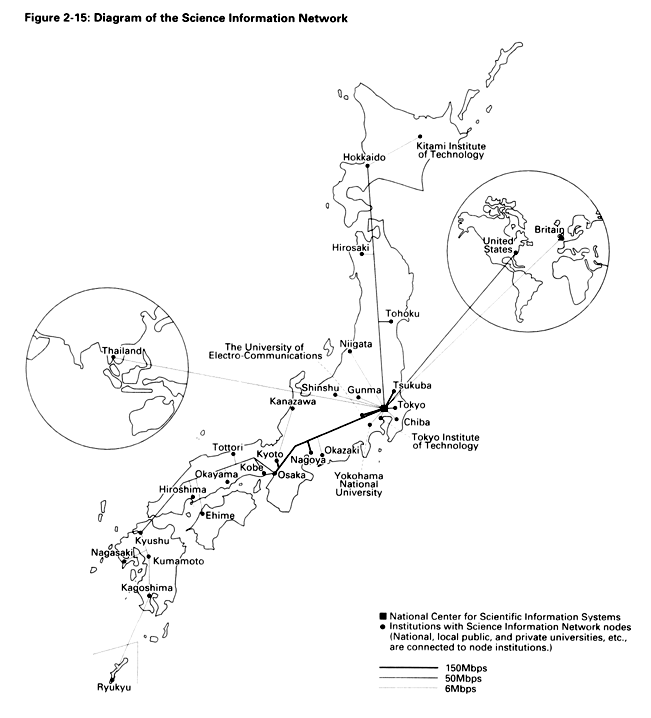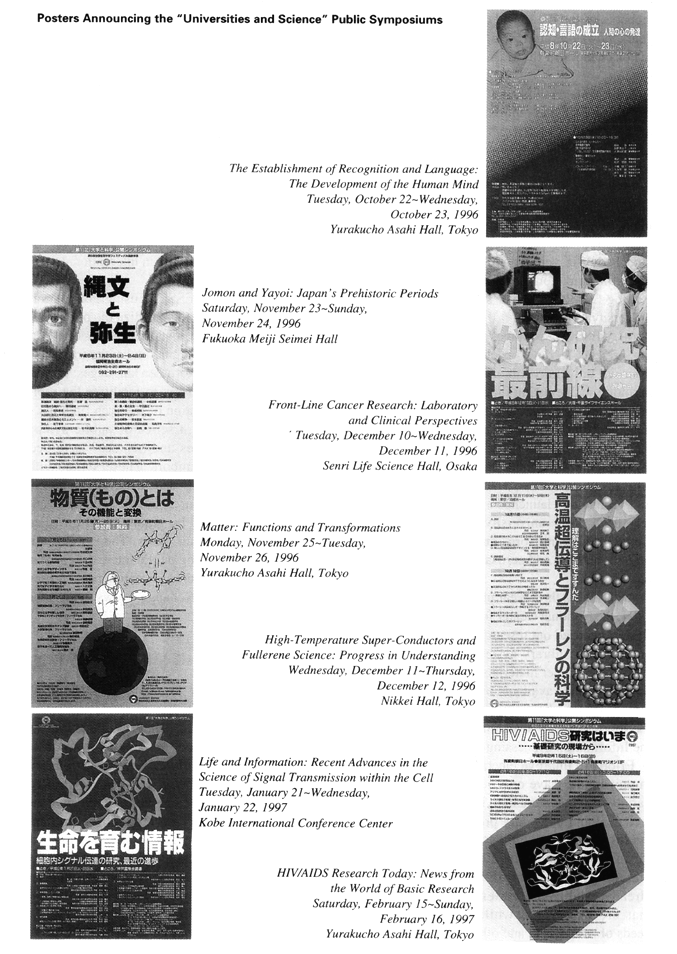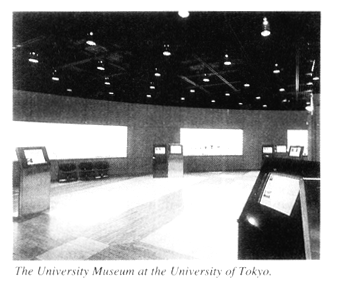| Home > Policy > White Paper, Notice, Announcement > White Paper > JAPANESE GOVERNMENT POLICES IN EDUCATION, SCIENCE, SPORTS AND CULTURE 1997 > Scientific Research Chapter 2 Section 1 4 | ||
The progress of scientific research in Japan has been paralleled by rapid growth in the volume of scientific information generated by research activities. This information is an extremely valuable resource, stimulating research activities, giving greater depth to exchanges among research workers, and aiding researchers in producing the optimal results by enabling them to stay accurately informed about developments in related fields.
Researchers need access to an expanding and increasingly diverse range of scientific information, and the prompt, accurate provision of such resources is vital to the continuing advancement of Japanese scientific research in a highly information-intensive society. Also important is the wide dissemination, in Japan and overseas, of outstanding results produced by Japanese researchers.
Plant and animal specimens, fossils, and other materials collected over the years in the course of scientific research in universities also constitute a vital resource for research and education. In particular, in conjunction with the dramatic advances made in bioscience in recent years, many types of phylogenetic organisms are gaining in value because of their great importance as genetic resources for researchers working in such fields as biology, medicine, pharmacology, and agricultural sciences.
MESSC is therefore working to establish and upgrade scientific information distribution systems, such as networks and databases. It is also improving systems for the collection, storage, and distribution of scientific materials, including genetic resources.
(a) Science Information Network (SINET)
: The growing sophistication of scientific research in recent years has been paralleled by an increase in the quantity and variety of scientific information distributed via computer networks. Setting up and enhancing networks as infrastructure for the rapid, reliable gathering and distribution of information in Japan and internationally is important to the continuing advancement of scientific research.
Japan's Science Information Network links universities and other institutions nationwide through the National Center for Science Information Systems. MESSC is speeding up the network and extending its international links. The number of institutions in the network is increasing steadily, totaling 61 3 as of March 1997, including 364 universities (89 national, 38 local public, and 237 private) and 249 other institutions.
Efforts to improve the network are also focusing on line speeds. Part of the main trunk line has been upgraded to 150Mbps. * Of the international links to the United States, Thailand, and the United Kingdom, traffic on the link to the United States is especially heavy, and in October 1997 the connection was upgraded from 6Mbps to 45Mbps ( Figure 2-15 ). Future plans call for increasing network speed to the U.S. level as soon as possible and eventually achieving gigabit line speeds.
(b) Campus Information Networks (Campus LANS)
: Campus information networks link various computers within each university. They have been installed in all national universities and inter-university research institutes, with the exception of universities that are planning to relocate. ATM * exchanges are currently being installed to facilitate the distribution of multimedia information, such as audio data and motion pictures. To date, these systems have been installed in 58 national universities. MESSC plans to install ATM technology in all national universities.
MESSC is also providing private universities with subsidies for upgrading their information infrastructure, including campus LANS and information processing systems.
*Mbps: Megabits per second. An Mbps is a unit of transmission speed equivalent to 1million bits (about five newspaper pages) per second.
The importance of electronic information has risen exponentially due to the rapid development of computer networks and advances in multimedia technology. Databases, in particular, have become extremely effective research tools by facilitating data searching, processing, analysis, and distribution. Databases that present information in structured formats that are easy to search, enabling users to retrieve what they need when they need it, have become a crucial element of the infrastructure for scientific research. The development of databases capable of making a global contribution has, therefore, become an urgent priority in Japan.
In FY 1 996 the National Center for Scientific Information Systems conducted a survey of scientific information databases. The results showed that the total number of databases maintained in universities had reached 2,01 6, of which approximately one-half (989) were open to the public.
MESSC subsidizes the creation of databases by researchers in universities and by academic societies and other organizations. The fiscal 1997 budget allocates \1,285 million in grants-in-aid for scientific research (Grants-in-Aid for Publication of Research Results) for this purpose, as well as \584 million for core institutions in fields where databases have practical potential.
In June 1997 the Science Council's Science Information Subcommittee produced an interim report on ways to develop scientific databases. On the basis of this report, MESSC will implement various measures, including the expansion of funds to promote grants-in-aid for the publication of research results. It will also consider systemic improvements.

*ATM: Asynchronous Transfer Mode. This state-of-the-art, ultra-high-speed communications system sup-ports simultaneous transfers of large volumes of multimedia Information, including text, audio data, and moving pictures.
University libraries play a very important role as fundamental organizations for educational and research activities. The development of multimedia technology and the spread of the Internet in recent years, however, are forcing the libraries to make major changes in the way they provide information.
In accordance with the Science and Technology Basic Plan and reports and recommendations of the Science Council, MESSC is promoting the use of electronic technology in university libraries, primarily through the measures described below.
Efforts to improve electronic library functions in universities have only just begun, and a wide variety of issues remain to be resolved, including technical and budgetary problems and copyright questions. The long-term goal will be the creation of an ideal system in all universities, but at present it is important for universities that have already established systems to focus on tasks that are achievable while responding to the needs of researchers and other users and fostering cooperation among related internal organizations.
The results of scientific research have traditionally been publicized through books, scientific journals, or conference presentations. With the growth of communications networks in recent years, researchers, especially those in the natural sciences, have started using the Internet to disseminate articles in Japan and abroad. This method of publicizing research findings not only contributes to their dissemination in Japan, but also plays an important role in international scientific exchange.
In view of this, MESSC is using grants-in-aid for scientific research to subsidize the publication of academic society journals, collections of papers, and scientifically important books; the translation of scientific books into other languages; and the development of databases to facilitate the rapid, widespread dissemination of research findings.
Since fiscal 1986, a series of public symposiums on "Universities and Science" have been held with MESSC support. These symposiums provide a forum for the wide dissemination of information about research trends and the results of research supported by grants-in-aid for scientific research and other funds. The symposiums focus on areas of strong public interest, providing opportunities for leading researchers to present their findings and exchange views with other participants.
An academic society is an organization established through the initiative of researchers working in the same field. These associations are important forums where researchers from different universities and research organizations can come together to present and discuss research and share information. As joint research and other forms of cooperation by researchers in Japan and other countries become more common, academic societies also serve to disseminate Japanese scientific information, making them an important part of the infrastructure for scientific research.
The main activities of these organizations include publishing journals and collections of papers discussing the latest and best research findings, and holding research symposia, scientific gatherings, seminars, and other events. In recent years, academic societies have made an important contribution to the advancement of scientific research by publishing foreign language versions of their journals and collections of papers to send overseas and hosting a growing number of international conferences, thereby publicizing and disseminating research results at home and abroad.

MESSC subsidizes various activities of these organizations, including the publication of journals and collections of papers, the creation of databases, the hosting of international conferences and scientific symposia for young people and adults, and the standardization of scientific terminology. It also assists some incorporated nonprofit organizations (incorporated academic societies) by, for example, awarding special public interest corporation * certification to non-profit organizations that engage in the activities of an academic society, providing certain conditions are met.
Contributions to special public interest corporations are tax-deductible in the case of individuals; in the case of corporations, donations can be listed as "special registration of a pecuniary loss" within the permissible limits for general donations.
It is very important to the progress of scientific research that diverse and obtuse terminology be organized and integrated and rendered in clear, simple language. Terminology is a highly significant part of the infrastructure for distributing scientific information.
Since 1947, in line with reports and recommendations from the Science Council, MESSC has been working with academic societies to establish terminology for individual fields of specialization and endeavoring to disseminate this terminology through the compilation and publication of Japanese Scientific Terms. To date, terminology has been established for 30 fields, including chemistry, electrical engineering, agricultural sciences, and psychology. The lists for 15 fields, including astronomy, instrument technology, and library and information science, have been revised.
* special public interest corporations: These are corporations that are certified under the Income Tax Law Enforcement Ordinance and the Corporation Tax Enforcement Ordinance and that make a significant contribution to the promotion of the public interest, including promoting education or science, improving culture, or contributing to social welfare.
Dramatic progress in bioscience in recent years has made phylogenetic organisms important genetic resources because of their genetic interchangeability. As research resources, they provide invaluable models that can contribute to our understanding of human biological mechanisms and the causes of disease, as well as to our efforts to maintain health and solve food and environmental problems.
In June 1996 the Science Council's Science Materials Subcommittee produced recommendations "On the Utilization of Biological and Genetic Materials in Scientific Research." In FY 1 997 MESSC accordingly established and equipped the Biological and Genetic Resources Center, which will play a central role in systematic storage of materials for each type of organism in Japan, and the General Biological and Genetic Information Center, which will gather and distribute information about biological and genetic materials and provide overall coordination for the systematic storage of those materials. These centers will facilitate the supply of biological and genetic materials while helping to build closer cooperation among individual researchers and research organizations in Japan. Through these roles, they are expected to make an important contribution to the progress of advanced research in bioscience fields. MESSC will continue to develop resource centers for essential types of organisms, taking into account research needs and performance in research and systematic storage.
Optimal precision in experimental work is essential to research in fields like medicine and pharmacology. This requires securing laboratory animals, and improving facilities and equipment for animal experiments as well as methods of raising and managing laboratory animals. In May 1967 the Scientific Materials Committee of the Science Promotion Council issued recommendations for the improvement of animal experiments in universities. Since fiscal 1971, MESSC has been setting up modern, centrally managed animal-experimentation facilities in universities with medical schools. The purpose of these facilities is to provide an environment that ensures high degrees of accuracy and reproducibility in animal experiments, to support centralized breeding and management of high-quality laboratory animals, to develop and study laboratory animals, and to provide guidance and education for staff and students undertaking animal experiments.
Recent progress in bioscience is reflected in the increasingly diverse and sophisticated aims and content of the experiments performed by researchers who use animal-experimentation facilities. The rising standard of research in Japan and overseas makes it necessary to attain ever higher levels of precision in experiments. It is also important to conduct animal tests safely and appropriately. Developments in genetic engineering and embryological engineering have made it possible to manipulate the genes of individual animals, leading to the creation of mice with transplanted or missing genes. Animals with modified genes are now an essential research resource for bioscience, including brain research.
MESSC is currently promoting the development of centers to handle preservation, supply, development, and training tasks relating to genetically modified animals. This work is based on a July 1997 report by the Science Materials Subcommittee of the Science Council titled "The Storage, Supply and Development of Genetically Modified Animals."

Scientific specimens, such as animal and plant materials and fossils, are the products of long years of scientific research in universities or systematic collection for research purposes. These materials embody a wide range of concrete information and are Indispensable to scientific research. The recent development of new analytical methods, such as DNA and isotope analysis, has enhanced the importance of these materials as research and education resources that can be approached from different perspectives by different research fields.
Many universities in Europe and North America have established university museums housing extensive collections of scientific specimens. In addition to contributing to multi-faceted research on scientific specimens, these facilities are also playing an active role as centers for the distribution and reception of scientific information.
In January 1996 the Science Materials Subcommittee of the Science Council produced a report titled "The Establishment of University Museums," in which it recommended the creation of similar facilities in Japanese universities to collate, store, publicize, and display scientific specimens, provide information, and conduct systematic, original research and educational activities using the specimens. The report emphasizes the need for university museums as interfaces for "universities that are open to the community," and as facilities that can respond to a variety of learning needs.
In line with these recommendations, MESSC established the University Museum at the University of Tokyo in FY 1 996 and the Kyoto University Museum in FY 1997. The ministry will continue to set up university museums, taking into consideration educational and research achievements utilizing scientific specimens, the state of storage and organization of such materials, and regional characteristics.
| Back to Top | MEXT HOME |